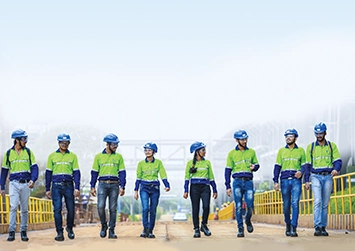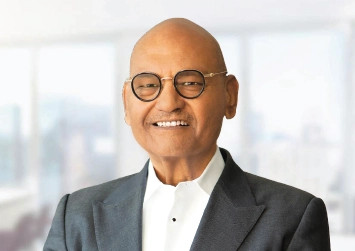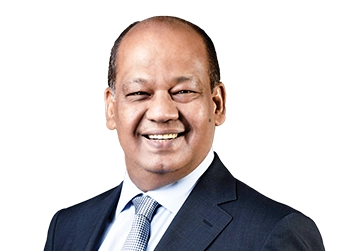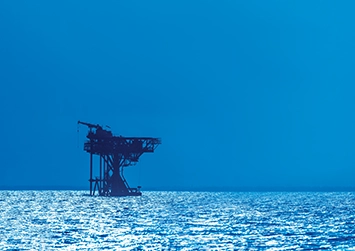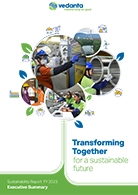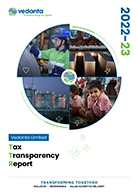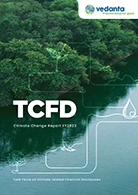SEGMENT OVERVIEW
Overview
The year kicked off on a positive note with zinc prices hovering around US$4,000-4,400 per tonne (/t) levels as supply chain got impacted amidst the Russia-Ukraine war and China’s zero covid policy led lockdown. However, the market was subject to volatility throughout the year; zinc prices even touched US$2,682/t level in November 2022. It closed at US$2,907/t during the end of March 2023.
The global refined zinc demand contracted by 3% to 13.6 million tonnes in CY 2022, largely due to a fall in Chinese demand. At supply level, the refined zinc production fell by 2.6% in CY 2022, due closure of several smelters globally for care and maintenance as the energy prices increased. Consequently, the global zinc warehouse stocks also fell during this period. In FY 2023, the total tonnage of zinc at Shanghai Futures Exchange (SHFE) warehouses and LME fell to 97 kt and 45 kt respectively during the end of March 2023.
Indian refined zinc demand, however, was robust and is estimated to have increased by ~3% in CY 2022 mainly driven by demand from the infrastructure and Galvanising industry.
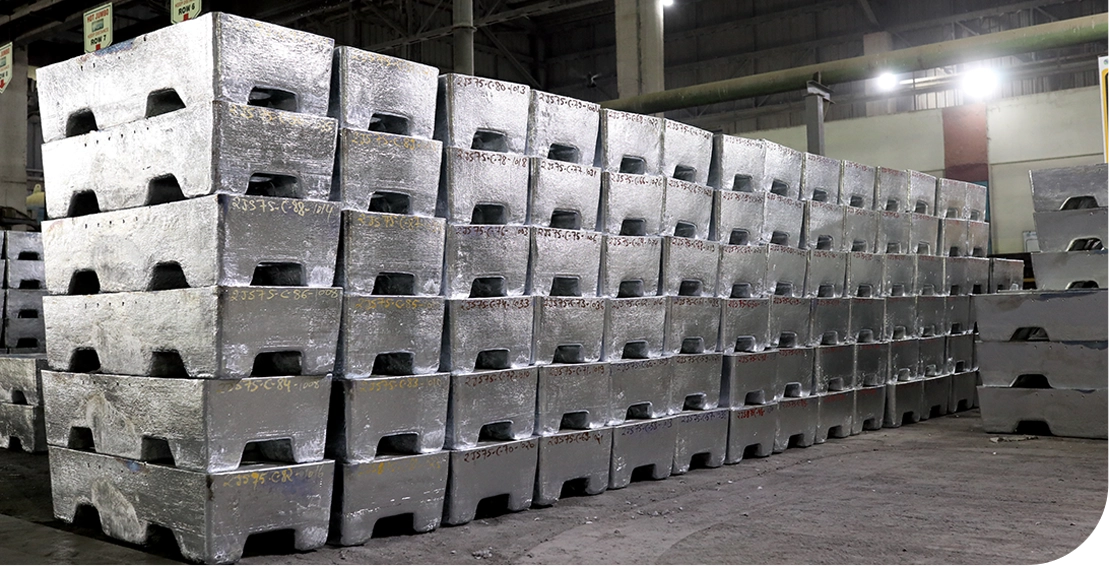
Market Drivers
The global zinc demand is expected to grow by 3.5% in CY 2023 majorly driven by stronger offtake from China and India. In India, the zinc demand is expected to increase by 10% in CY 2023 driven by demand from infrastructure and automobile sector.
In domestic market, Indian Railways has been a key demand driver for zinc. With a focus on safety and speed, it has introduced 18 Vande Bharat trains till now (another 478 trains planned) and is also working on different mechanisms to protect rail network from corrosion. Strong focus on developing road, power generation and transmission and 5G related telecom infrastructure are likely to create demand. Together, these are expected to bolster zinc consumption in India
Products and customers
Hindustan Zinc Limited (HZL) is the largest primary zinc producer in India. In FY 2023, it had 77% domestic market share; it sold ~60% of its refined zinc volume in the domestic market and exported rest of the volume to South-East Asian and Middle Eastern markets.
Over 70% of the zinc demand in India comes from galvanising steel, predominantly used in the construction and infrastructure sectors. HZL has a strong portfolio aligned to these needs comprising continuous galvanising grade, electroplatting grade and two grades of zinc for use in die-casting alloys, which make it an attractive player. The Company is working closely with its customers to increase the proportion of value-added products (VAP) in its zinc portfolio. It strives to increase VAP mix to 23% of total zinc sales in FY 2024, up from 16% in FY 2023.
Overview
Historically, lead is believed to be insulated from cyclical demand movements compared to the other metals. However, lead prices in FY 2023, especially during first half of the year, experienced significant volatility. Starting with a 12-month high of US$2,471/t in April 2022, lead prices fell to a 23-month low of US$1,754/t in September 2022. The prices improved in 2H FY 2023 driven by China’s reopening. LME price stood at around US$2,100/t level at the financial year end.
Global lead market, including primary and secondary markets, saw demand growth of 1.5% to 13.4 million tonnes in CY 2022 compared to 4.3% growth in CY 2021.
Demand outstripped supply and lead inventories fell to historically low levels. In first nine months of FY 2023, lead inventory in LME declined by ~36% to 25 kt and that in SHFE by ~60% to 35.2 kt.
In India, the refined lead market, including both primary and secondary markets, increased 8.2% to 1.2 million tonnes in CY 2023; the primary lead market demand was ~250 kt.
Market Drivers
The domestic refined lead consumption is expected to grow by 4.2% in CY 2023. With faster consumption growth against minimal mine supply growth, the markets are expected to be tight with no surplus.
Increasing urbanisation and industrialisation in developing countries along with rising automotive consumption are expected to be the key drivers for lead demand. In the domestic market, the demand for lead is expected to be robust, largely on the back of continued demand momentum in automotive sector, which witnessed excellent growth in the passenger vehicle and two-wheeler sales in FY 2023. The demand from the industrial battery segment is also expected to remain robust with battery replacements in data centres, banks, ATMs and other critical applications gathering pace. Given India’s ambitious renewable energy focus, emerging areas like energy storage for electricity generated from photovoltaics are likely to add to the demand.
Products and customers
HZL is a leading primary lead producer in India; it produces 99.99% purity lead ingots. In FY 2023, it had ~85% share of the primary domestic market. It sold 91% of its production in domestic market and exported 9% to other geographies. Considering the opportunities in the Indian market, the Company intends to become 100% domestic market focussed through new customer acquisition, leveraging e-commerce platforms and introducing lead alloys.
Overview
CY 2022 saw the silver demand reach new highs driven by strong industrial demand, jewellery and silverware offtake and physical investment. The global silver demand rose by 17% in CY 2022 to 1.24 billion ounces (Boz). The industrial demand for silver increased by 2.6% to 550 million ounces (Moz) in CY 2022, driven by vehicle electrification, government’s expanding commitment to green infrastructure and rising 5G adoption.
FY 2023 started positively with London Bullion Metals Association (LBMA) silver prices reaching US$24.54 per troy ounce (/toz) in April 2022. However, with the market volatility, the prices declined to US$17.77/toz during September 2022. The prices picked up gradually to reach US$23.75/toz in January 2023 and stood at average US$21.9/toz during March 2023.
Market Drivers
Global silver supply is expected to rise by 4% to 1.005 Boz in CY 2023. Silver mine production is expected to grow by 5% to reach 0.873 Boz in CY 2023, due to new silver mines in Mexico and increased output from Chile gold operations with high silver content. The silver recycling growth is expected to be 3%.
Global silver demand, though, is expected to dip to 1.15 Boz in CY 2023. The decline would be primarily on account of softness in jewellery and physical investment demand. The long-term prospects for silver investments (both physical and ETF) remain strong. Silver coin demand in India is also encouraging. While it has largely been driven by gifting and religious purposes, which insulates it from price fluctuations, its demand has increased in recent years because of the different product offerings and marketing efforts from mints and refineries.
However, global industrial demand for silver is expected to increase by 2.6% to 550 Moz. The solar panel manufacturing industry has been increasingly consuming silver, driven by government’s support in terms of production linked incentives (PLI) to promote the usage of renewables. The use of silver for vehicle electrification and creation of charging stations is also likely to rise.
Products and customers
HZL is India’s only primary silver producer and ranks 5th globally among the top silver producing companies. HZL sells silver exclusively in the domestic market. It is used in industry (electrical contacts, solder and alloys, and pharmaceuticals), jewellery and silverware. The Company also offers spot sales of silver through e-auction to reduce manual intervention, thus ensuring equal opportunity for buyers to compete along with complete price transparency.
Overview
The aluminium market during CY 2022 started on a positive note with LME prices steeply rising to all-time high of US$3,849/t in March 2022. However, the market was significantly impacted by volatility in macroeconomic conditions during the year amidst the ongoing RussiaUkraine war, European energy crisis, and high inflation in the key markets. Consequently, the market witnessed price declines as the year progressed; LME price stood at around US$2,350/t level during the end of March 2023.
In CY 2022, global primary aluminium production increased by 2.5% to 69 million tonnes while demand is estimated to have increased by 0.4% to 69.2 million tonnes resulting in global deficit of 0.2 million tonnes. In China, the largest market, primary production increased by 4.5% while demand increased by 1.2%. In rest of the world (RoW), both production and consumption were flat.
In India, the domestic demand is likely to have surged 17% from ~3.9 million tonnes in FY 2022 to around 4.6 miliion tonnes in FY 2023; majorly driven by primary aluminium demand on robust economic growth with high industrial and manufacturing activities supported by government initiatives.
Market Drivers
Global total aluminium demand is expected to increase at a CAGR of ~3% from 96 million tonnes in CY 2022 to 122 million tonnes in CY 2030 driven by multiple factors. The decarbonisation transition in transportation and packaging industry is expected to push aluminium demand. Aluminium consumption from renewable energy and electric vehicle sectors is expected to increase from 6 million tonnes in CY 2022 to 16 million tonnes by CY 2030.
CY 2023 is expected to witness demand improvements from both China and rest of the world. China’s primary aluminium demand is expected to increase by 2-3% mainly due to government stimulus policies.
Indian domestic aluminium demand is likely to be driven by key consuming segments like electronics and appliances as well as anticipated boom in renewable, defence, and aerospace sectors.
Products and customers
Vedanta is India’s largest primary aluminium producer with an annual capacity of ~2.3 million tonnes. It has a market share of 41% (as of March 2023) in the domestic market; its domestic sales volume increased by 28% in FY 2023. The Company also has a sizeable OEM base globally that consumes its value-added products.
The Company’s product portfolio includes aluminium ingots, primary foundry alloys, wire rods, billets, and rolled products which cater to varied industries globally such as power, transportation, construction and packaging, defence, renewable, automobile and aerospace among others.
In line with the evolving market needs and the focus on value creation, the Company has been steadily strengthening its market position with focus on value-added product (VAP) portfolio which currently accounts for ~38% of its total aluminium sales globally. The Company is working on projects to increase its total aluminium capacity to 3 MTPA and VAP mix to ~100% along with improvement in backward integration.
Overview
According to the US IEA, the global oil supply increased by 4.7 million barrels per day (mbpd) to 100.1 mbpd in CY 2022, with the US, Russia and the Organisation of the Petroleum Exporting Countries (OPEC) being the major contributors. At the same time, the global oil demand increased by 2.2 mbpd, driven by both Organisation for Economic Co-operation and Development (OECD), primarily the US, and non-OECD countries, primarily India, and the Middle East. Indian oil demand increased by 8%.
Crude production and consumption (mbpd)
Oil market was subject to elevated volatility amidst multiple macro and geopolitical events in CY 2022. This included Russia’s invasion of Ukraine in late February 2022 and the ensuing sanctions, embargoes, and price cap on its oil imports. Further, recessionary and inflationary pressures on the global economy, China’s low oil demand due to stringent zero-COVID policies, and the transformed crude and product trade flow also impacted the market. The global oil market adjusted to these shocks and physical supplies were marginally hit. The losses in Russian supplies were limited due to unwinding of OPEC+ cuts, release of oil from the strategic petroleum reserve (SPR), and the ability of Russia to redirect its exports from Europe to other parts of the world. India emerged as a key destination, with share of Russian crude in its overall import basket increasing from 0.2% levels to highs of ~27% in January 2023.
These elevated uncertainties shaped supply demand balance and market expectations, as partly reflected in extreme price movements in CY 2022. During majority of the first half of CY 2022, crude oil prices traded above US$100 per barrel (/ bbl). However, it softened gradually during second half of CY 2022 and returned to pre‑Russia-Ukraine war level of US$70-75/bbl by March 2023.
Brent, $/bbl
Market Drivers
As per OPEC, the global oil demand is expected to increase by 2.5 mbpd to 101.9 mbpd in CY 2023 with a potential upside coming from the opening of the Chinese economy and increased demand for jet fuel and kerosene. Global oil supply driven by the US, Brazil, Norway, Canada, Kazakhstan, and Guyana are expected to exceed demand during the first half of CY 2023. However, second half of CY 2023 is expected to be oil deficit with demand recovery and continued decline in Russian output due to the sanctions imposed. Nevertheless, large uncertainties remain over the impact of ongoing geopolitical developments, as well as the output potential for the US shale in CY 2023.
According to the US Energy Information Administration (EIA), brent crude oil spot prices will average at US$83 per barrel in CY 2023. Global economic outlook uncertainty and rising crude inventory will impact crude oil prices, however, the pressure will be limited due to high demand from Asian markets.
India, the world’s third largest oil consumer and the fourth largest refiner, currently meets 87% of its oil consumption and 50% of its gas consumption through imports. In CY 2023, India’s demand is projected to increase to 5.39 (+0.02) mbpd, supported by increasing airline activities and projected GDP growth of 5.6%. The government’s proposed increase in capital spending will boost construction and manufacturing activities, thereby, driving the oil demand in India.
Products and customers
Cairn India is the largest private oil & gas exploration and production company in India with gross proven and probable R&R of 1,151 million barrels of oil equivalent (mmboe). The Company’s crude oil is sold to public and private refineries and its natural gas is consumed by the fertiliser industry and the city gas distribution sector in India.
100% of the Company’s crude oil and natural gas production in FY 2023 was sold in India as per government regulation. The Company is focussed on strengthening its dominance in the Indian market, with an ambition of producing 50% of India’s oil & gas.
Overview
India is the 3rd largest electricity producer in the world after China and the US, with an installed capacity of 411 GW, as of 31 March 2023. Energy being an important input for economic growth and development, India has seen rapid growth in electricity demand over the years, in line with its economic development. In FY 2023, India’s total electricity demand grew by 9.5% to reach record highs of 1,511 billion units (BUs) while the total electricity generation grew 8.7% to 1,624 BUs.
There is strong focus on creating new capacities to meet the country’s burgeoning energy demand. The Government of India (GoI) has set a vision to double the power capacity by 2030, to keep pace with the growing population, increasing electrification and per capita usage.
Market Drivers
According to the Central Electricity Authority (CEA), India’s annual electricity consumption is estimated to grow at an average of 7.2% per annum over next five years, driven by expansion in industrial activities, growing population, rising per capita income, and increasing electricity penetration. In line with the demand projections, the country’s installed capacity is estimated to register a 10+% CAGR during FY 2022-27.
Multiple initiatives by the government are encouraging growth and investment in the power sector. This includes policy support such as delicensing the electrical machinery industry, allowing 100% foreign direct investment (FDI) and the focus on ‘Power for All’ through various schemes. This includes Saubhagya, Integrated Power Development Scheme, Deen Dayal Upadhyaya Gram Jyoti Yojana, Unnat Jyoti by Affordable LEDs for All, Restructured Accelerated Power Development and Reforms Programme, Ujwal DISCOM Assurance Yojana and National Infrastructure Pipeline.
To ensure climate compatible growth, renewable energy is expected to be a preferrable mode with a target to expand its capacity to 500 GW by 2030. PLI scheme and policies like the Green Energy Open Access Rules, Energy Conservation (Amendment) Bill 2022 and renewable energy generation and utilisation (renewable purchase obligations) are incentivising this change. The Union Budget FY 2023-24 has also given due importance to renewable energy with increased capital outlay.
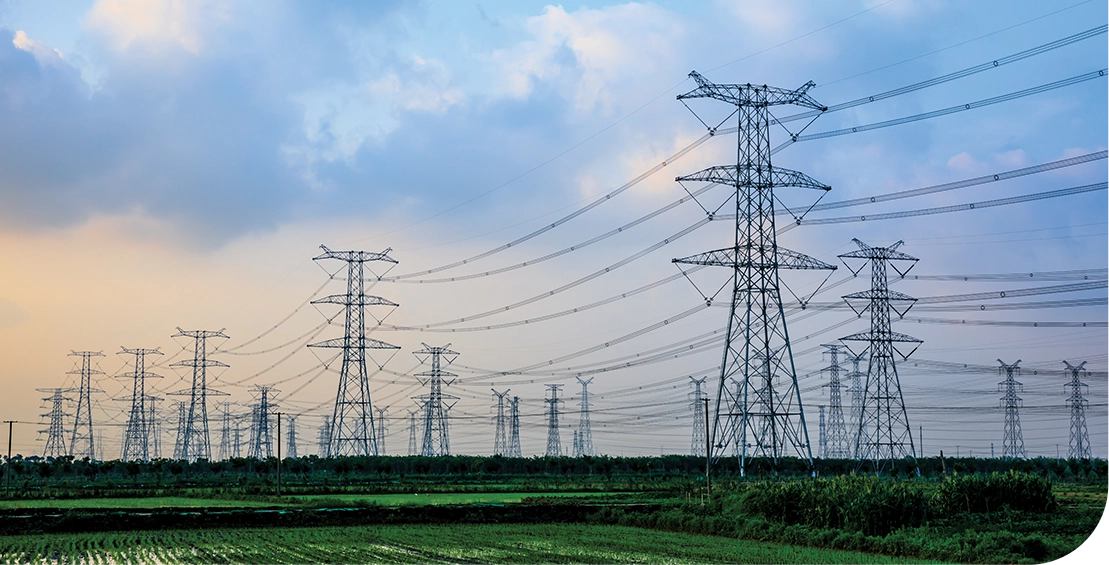
Products and customers
Vedanta has a power portfolio with a total capacity of ~ 9 GW. These power assets are at Talwandi Sabo, Jharsuguda, Korba, Lanjigarh. 37% of the total capacity is used for generating power for commercial purposes, backed by long-term power purchase agreements with state distribution companies of Punjab, Tamil Nadu, Kerala, Chhattisgarh, and Odisha. The remaining 63% power generated is deployed in captive operations at Aluminium and Zinc businesses.
Vedanta has set itself a target to achieve 2.5 GW round the clock renewable energy (RE RTC) capacity by 2030 and has signed power delivery agreements for 788 MW RE RTC by the end of FY 2023.
Overview
India is the second-largest steel producer in the world. Steel is one of India’s core industries, contributing more than 2% to the GDP. In FY 2023, India’s crude steel production increased by 4% to 125 million tonnes.
Indian government’s continuous focus on infrastructure building has led to an increase in Indian steel finished consumption by 13% to 119 million tonnes in FY 2023. In eastern states, steel demand was relatively higher due to the projects like Hockey World Cup in Odisha and various rail bridge constructions in the North-Eastern belts.
The steel product prices, however, have been volatile. The domestic long steel prices reached highs of ~`70,000/tonne during April 2022, as raw material prices increased following the Russia-Ukraine war. However, with increase in export duty during May-December, 2022, the prices fell as domestic market-focussed producers liquidated inventories. Prices recovered back to `60,000/tonne levels during March 2023 with reversal of export duty, and subsequent uptick in export orders along with improved domestic demand.
Market Drivers
In FY 2024, steel demand in India is expected to be robust. The government’s push to increase steel production as per the National Steel Policy, focus to make India a US$5 trillion economy and ‘Make in India’ policy are likely to support the industry. Demand from the major sectors such as infrastructure (including railways, metros, freight corridors), construction and housing, renewables and automobiles is expected to be strong supported by Union Budget 2023-24’s push for infrastructure creation through `10 lakh crore capital expenditure outlay.
Railways have been allocated `2.40 lakh crore with plans to bring 4,000 km of railway network under ‘Kavach’, a train protection system, in FY 2024. Further, increased activity in UDAN scheme to construct 100 airports, a higher allocation of `80,000 crore to Pradhan Mantri Awas Yojana and a resurgence in automobile sector (expected to attract `74,850 crore investment as part of PLI scheme) are likely to boost steel demand. Additionally, the proposed import duty reduction for machine parts used to produce Li-ion batteries in electric vehicles, may boost auto industry and hence the steel consumption.
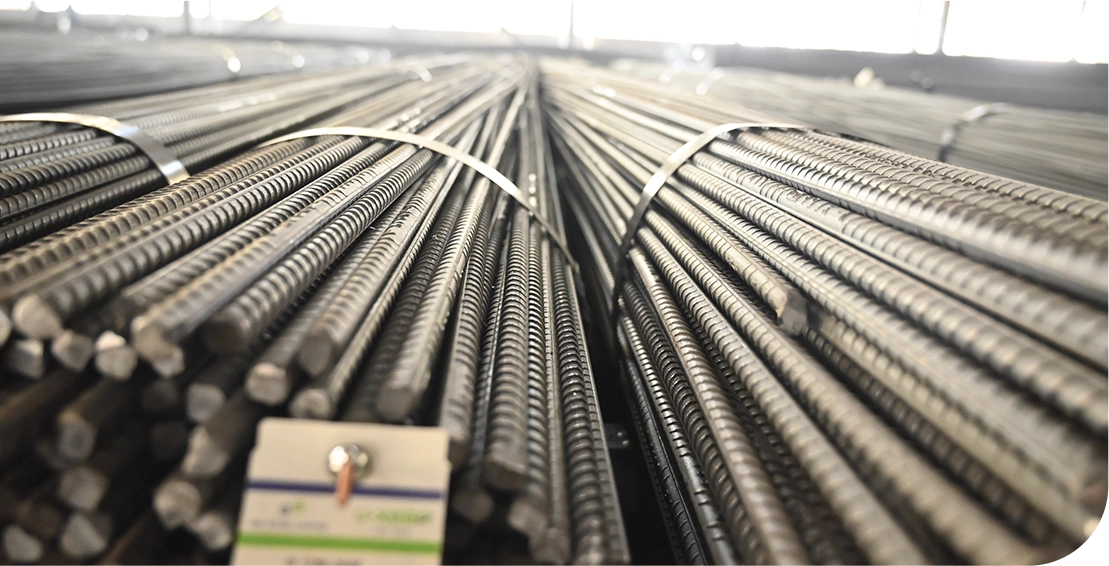
Products and customers
ESL Steel Limited presently has 1.5 MTPA of steel manufacturing capacity, with projects underway to expand the capacity to 3 MTPA in FY 2024. The Company’s portfolio includes pig iron, billets, TMT bars, wire rods and ductile iron pipes which are sold across construction, infrastructure, transport, energy.
In FY 2023, the Company developed various new wire rods grades, including Boron Alloy Grades in co-ordination with customers to meet their requirements. It received several notable accreditation approvals, including from UK CARES for TMT. It also secured various domestic approvals, such as blanket approval from the National Highways Authority of India and UP Metro Rail corporation, UP Bridge Corporation, Satluj Jal Vidyut Nigam, IOC Panipat Refinery, Jal Jeevan Mission, Water Corporation of Orissa and Rural Water Supply and Sanitation department. The Company further added several esteemed customers to its portfolio, from infrastructure, steel and engineering sectors.
For FY 2024, ESL is prioritising developing value-added grades of wire rods, increasing alloy grades and enhancing retail segments. The Company is also focussed on digitalisation to ensure fair price recovery and conducting auctioned sales for prime grades of all products.
Overview
Global iron ore prices witnessed significant volatility in CY 2022. The prices reached a peak of US$160/t in March 2022, driven by concerns over loss of significant supply in the context of geopolitical conflict in Europe. The prices gradually dropped through the year to touch a low of US$79/t in October 2022, owing to weakness in Chinese real estate sector. However, the iron ore prices firmed up in the following months and stabilised around ~US$120-130/t level in March 2023.
In India, FY 2023 iron ore production was stable at ~250 million tonnes with 6% increase in domestic steel production. However, iron ore exports fell by ~23% to ~20 million tonnes as Government of India (GoI) increased iron ore export duty in May 2022. Iron ore prices moved in tandem with global price movement during early CY 2022, however, the pricing later was decoupled due to sudden increase in export duty. In November 2022, GoI reversed the additional export duty. Iron ore prices increased in March 2023 driven by a seasonally strong steel sector demand and export opportunities.
Market Drivers
Indian iron ore production is expected to increase to 260 million tonnes by FY 2025. Iron ore exports from India are expected to increase with the removal of iron ore export duties and Karnataka iron ore export ban. The positive shift was evident in growing exports during last quarter of FY 2023 and is likely to sustain.
Global iron ore prices are expected to sustain in near term, driven by recovery in China’s economy and specifically its construction sector post lifting of Covid restrictions. Additionally, a decrease in production from key producers, Australia and Brazil, is expected to further strengthen the prices.
Products and customers
The Company produces iron ore and pig iron, and caters to steelmaking, construction, and infrastructure sectors. It sells more than 65% of pig iron and 69% of iron ore in the domestic market.
In FY 2023, the Company strengthened its industry position by ramping up mining operations. It bagged iron ore blocks FEE grade and BICO in Odisha’s

Sundargarh in FY 2022 and operationalised both the mines in FY 2023 with a combined capacity of 5.5 MTPA. It also started mining operations in Bomi mine Liberia, achieving a production run-rate of 0.2 MTPA as on 31 March 2023. The Company expanded its geographic reach in India and won Bicholim mine in Goa, with resources of 84.92 MTPA.
Overview
High carbon ferro chrome (HCFC) is a key raw material in stainless steel, adding special characteristics of noncorrosiveness, high durability and temperature resistance. Over 80% of all ferrochrome goes into manufacture of stainless steel, making it a key demand driver. South Africa is the largest HCFC supplier and has significant bearing on market dynamics. However, Asia led by China is the largest consuming markets with 85% and 60% of the global HCFC consumption, respectively. China’s large overall import/merchant demand continues to make it the most influential market for global supply-demand dynamics and prices.
In CY 2022, global HCFC production stood at ~15 million tonnes and India produced ~1.3 million tonnes, making it the fourth largest producer. India remained an export-oriented HCFC producer with 60% of the volume being exported.
HCFC prices in FY 2023, especially during first half of the year, experienced volatility. In April 2022, the prices were at a 12-month high of US$1,592/t. However, it fell to a 15-month low of US$1,173/t in September 2022. During second half of the year, the prices improved with China reopening; prices stood at around US$1,350/t level at the year end.
Market Drivers
Stainless steel demand and prices are the key market drivers for HCFC. With growing demand from infrastructure projects in developing countries and demand resumption from the largest market of China, stainless steel production is expected to grow at 4-5% for next fiscal. This is expected to drive demand for global HCFC. The global HCFC production is likely to grow at 3-4%.
India is poised to be the fastest growing market, with both stainless steel and HCFC production projected to grow at 7-8%. India’s growth will be supported by largest-ever capital allocation for infrastructure creation including highway and airport development, railway network modernisation, and increased focus on housing construction.
Products and customers
Though India is an export-oriented country, Ferro Alloys Corporation (FACOR) is the second largest supplier of HCFC in the domestic merchant market. In FY 2023, FACOR sold 85% of its total ferro chrome volume within India, primarily to stainless steel and alloy steel producers.
The Company is focussed on developing value added products (VAP) portfolio. It increased its VAP capacity from 75 KTPA to 150 KTPA in FY 2023 to address niche markets in North America, Europe and South Korea. In FY 2024, the Company will be focussed on enhancing its volume and footprint both in Indian and global markets.
Overview
Copper experienced another volatile year in CY 2022. Copper prices soared to a record high above US$10,000/t in March 2022 owing to rising geopolitical tensions, inflation and energy costs. However, a downtrend owing to the fears of recession drove down prices to nearly two-year lows of less than US$7,000/t by July 2022. Since then, the prices have gradually been moving up and were average US$8,836/t during March 2023.
Overall global copper demand and supply were mostly flattish. Global refined copper consumption is estimated to have increased by 1.2% to 24.5 million tonnes. However, Indian copper market was strong in CY 2022; refined copper production and consumption increased by 10.5% to 550 kt and by 19% to 640 kt, respectively
Market Drivers
In CY 2023, a rapid recovery in global economic activity and rebound in China’s construction and automotive industry following its economic reopening are expected to improve copper demand. Globally, CY 2023, is estimated to be a supply deficit year for copper with an estimated 2.6% growth in refined copper consumption, which would provide support to prices. China’s refined copper consumption is expected to grow by 2.5% to 13.9 million tonnes and India’s refined copper consumption to grow faster by 12.5% to 720 kt in CY 2023.
India’s total copper demand is projected to reach 2.8 million tonnes by 2030 driven by building and construction, manufacturing, transportation, and consumer durable industries. EV segment would play a crucial role in driving demand given their higher copper content compared to traditional vehicles.
Products and customers
The Company has one of the largest copper production capacities in India. It produces a wide range of copper products including 8 mm copper rod, 11.42 mm/12.45 mm/12.45 mm wax free, copper cathode and copper car bar with housing wires, winding wires and cables, transformer and electrical profile producers being its primary customers.
The Company sold 96% of its FY 2023 volume in domestic market. It also has presence in export markets, namely Saudi Arabia, Qatar and Nepal. The Company is undertaking various projects towards manufacturing green copper to strengthen its competitive positioning.

